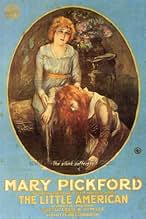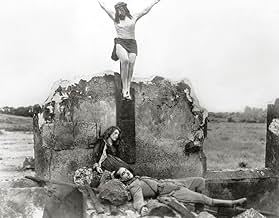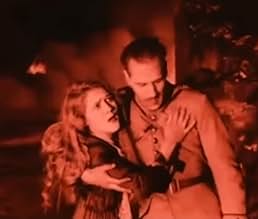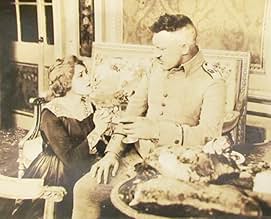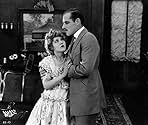Aggiungi una trama nella tua linguaA young American has her ship torpedoed by a German U-boat but makes it back to ancestral home in France, where she witnesses German brutality firsthand.A young American has her ship torpedoed by a German U-boat but makes it back to ancestral home in France, where she witnesses German brutality firsthand.A young American has her ship torpedoed by a German U-boat but makes it back to ancestral home in France, where she witnesses German brutality firsthand.
- Regia
- Sceneggiatura
- Star
Wallace Beery
- German Soldier
- (non citato nei titoli originali)
Olive Corbett
- Nurse
- (non citato nei titoli originali)
Lucile Dorrington
- Nurse
- (non citato nei titoli originali)
Clarence Geldert
- Submarine Commander U-Boat 21
- (non citato nei titoli originali)
Carl Gerard
- Reverend
- (non citato nei titoli originali)
Robert Gordon
- Wounded Soldier
- (non citato nei titoli originali)
Gordon Griffith
- Child
- (non citato nei titoli originali)
Recensioni in evidenza
This film is blatantly an anti-German propaganda film to which audiences flocked because America declared war on Germany a few months before its release. It's very effective even today, as I found myself despising the Germans for their actions, which included killing civilians and raping some women. Mary Pickford plays the title character, uncharacteristically a grown woman instead of a child she played in most of her films during the silent era. She is wooed by German-American Jack Holt and French-American Raymond Hatton when war breaks out in 1914. The Germans are depicted as being overly brutal.
There was one scene that made me laugh, when the Germans break the door down to enter her aunt's home. Mary tells them in deadly ernest while waving a small American flag, "Gentlemen - you are breaking into the home of an American citizen - I must ask you to leave." The Germans, led by Walter Long, roared with laughter too. I couldn't decide if it was comic relief or if you were suppose to sympathize with Mary.
I rather enjoyed the film for what it was. It was paced well by DeMille and the acting was fine but typical of early silents. Walter Long made a good heavy - he can sneer with the best of them.
You may notice in the cast list some famous names (Wallace Beery, Ramon Novarro, etc.) without character names. You never actually see these actors, but they are known to have been in the film from various writings, including DeMille's autobiography.
There was one scene that made me laugh, when the Germans break the door down to enter her aunt's home. Mary tells them in deadly ernest while waving a small American flag, "Gentlemen - you are breaking into the home of an American citizen - I must ask you to leave." The Germans, led by Walter Long, roared with laughter too. I couldn't decide if it was comic relief or if you were suppose to sympathize with Mary.
I rather enjoyed the film for what it was. It was paced well by DeMille and the acting was fine but typical of early silents. Walter Long made a good heavy - he can sneer with the best of them.
You may notice in the cast list some famous names (Wallace Beery, Ramon Novarro, etc.) without character names. You never actually see these actors, but they are known to have been in the film from various writings, including DeMille's autobiography.
When the US entered World War I, the government forced Hollywood to churn out propaganda films. THE LITTLE American is probably the best of the lot because it stars Mary Pickford.
Pickford plays a young woman torn between two men: Jack Holt (German) and Raymond Hatton (French), but her decision is delayed because of the war as both men enlist.
When the ship Pickford is sailing on is sunk by the Germans (think Lusitania) because it is carrying munitions, Pickford has a great scene as she stands on the lifeboat and yells at the German commander. Later on, of course, she runs into both Holt and Hatton when she is being held as a war prisoner at a château.
Director Cecil B. DeMille provides one truly great scene in this film as Pickford and Holt are wandering through a bombed-out village. They pass a destroyed church of which only one wall remains standing. Against the wall is a very large crucifix. As they stand and watch, the wall collapses but the Jesus figure remains, suspended in mid air. It's a very surreal moment in a film that is otherwise very straightforward and un-artsy.
Pickford is, as always, a pleasure to watch. She was always a very natural actress who avoided the arm-waving histrionics many other actors of the day used. She's also very very pretty. Holt is very good here in a leading-man role. Hatton is OK. Among the list of name actors in "extra" parts are Wallace Beery, Ramon Novarro, Colleen Moore, Ben Alexander, Hobart Bosworth, Norman Kerry, Walter Long, James Neill, and Edythe Chapman.
Not a great film, but interesting to see US propaganda at work.
Pickford plays a young woman torn between two men: Jack Holt (German) and Raymond Hatton (French), but her decision is delayed because of the war as both men enlist.
When the ship Pickford is sailing on is sunk by the Germans (think Lusitania) because it is carrying munitions, Pickford has a great scene as she stands on the lifeboat and yells at the German commander. Later on, of course, she runs into both Holt and Hatton when she is being held as a war prisoner at a château.
Director Cecil B. DeMille provides one truly great scene in this film as Pickford and Holt are wandering through a bombed-out village. They pass a destroyed church of which only one wall remains standing. Against the wall is a very large crucifix. As they stand and watch, the wall collapses but the Jesus figure remains, suspended in mid air. It's a very surreal moment in a film that is otherwise very straightforward and un-artsy.
Pickford is, as always, a pleasure to watch. She was always a very natural actress who avoided the arm-waving histrionics many other actors of the day used. She's also very very pretty. Holt is very good here in a leading-man role. Hatton is OK. Among the list of name actors in "extra" parts are Wallace Beery, Ramon Novarro, Colleen Moore, Ben Alexander, Hobart Bosworth, Norman Kerry, Walter Long, James Neill, and Edythe Chapman.
Not a great film, but interesting to see US propaganda at work.
With the US having recently entered the First World War, the country's best known and most popular director teamed with its most beloved actress to fire a cinematic salvo in this flag-waving adventure.
In style this is something of a departure for DeMille. He more or less abandons his use of long takes, painterly shot compositions and predominantly visual narrative, in favour of rapid editing and lots of expository intertitles. Of course this is purely pragmatic it keeps the story moving along quickly and injects some excitement and tension into what is after all a propaganda piece. The heavier than usual use of intertitles also leaves no ambiguity about plot or character intention. Some of these editing patterns are quite effective for example, the crosscutting used when the ocean liner is torpedoed. However fans of DeMille's early silents will probably find themselves missing the more considered approach they will be familiar with. This is certainly one of his least graceful films.
The fact that The Little American is more action-centred means it is less acting centred there is not the same concentration on performance that you normally get with DeMille. For this reason this is not a particularly memorable role for Mary Pickford, and to be fair almost any actress could have played the part equally well. However the casting of Pickford would have been symbolic and psychologically effective at the time. Although the press had not yet labelled her America's sweetheart, she certainly occupied that position. Therefore DeMille did not have to go out of his way to endear the audience to the character of Angela Moore, because they had already formed an emotional attachment to Mary Pickford.
Regardless of how effective this picture was in its day it is really quite a mediocre effort when taken out of context. One interesting point though the one scene in The Little American that really looks like the typical DeMille is the one in which Pickford and Holt take refuge in a ruined church below the effigy of Christ on the cross. Throughout the picture the stars and stripes is treated with the same reverence and significance DeMille might give to a crucifix. This picture is another small step towards the iconic imagery and preachiness that would characterise his work from the twenties onwards.
In style this is something of a departure for DeMille. He more or less abandons his use of long takes, painterly shot compositions and predominantly visual narrative, in favour of rapid editing and lots of expository intertitles. Of course this is purely pragmatic it keeps the story moving along quickly and injects some excitement and tension into what is after all a propaganda piece. The heavier than usual use of intertitles also leaves no ambiguity about plot or character intention. Some of these editing patterns are quite effective for example, the crosscutting used when the ocean liner is torpedoed. However fans of DeMille's early silents will probably find themselves missing the more considered approach they will be familiar with. This is certainly one of his least graceful films.
The fact that The Little American is more action-centred means it is less acting centred there is not the same concentration on performance that you normally get with DeMille. For this reason this is not a particularly memorable role for Mary Pickford, and to be fair almost any actress could have played the part equally well. However the casting of Pickford would have been symbolic and psychologically effective at the time. Although the press had not yet labelled her America's sweetheart, she certainly occupied that position. Therefore DeMille did not have to go out of his way to endear the audience to the character of Angela Moore, because they had already formed an emotional attachment to Mary Pickford.
Regardless of how effective this picture was in its day it is really quite a mediocre effort when taken out of context. One interesting point though the one scene in The Little American that really looks like the typical DeMille is the one in which Pickford and Holt take refuge in a ruined church below the effigy of Christ on the cross. Throughout the picture the stars and stripes is treated with the same reverence and significance DeMille might give to a crucifix. This picture is another small step towards the iconic imagery and preachiness that would characterise his work from the twenties onwards.
According to his autobiography The Little American is the film that Cecil B. DeMille wanted to make with Mary Pickford. Both were strong supporters of the Allied cause in World War I. But Adolph Zukor wanted a box office draw with a western so A Romance Of The Redwoods was done first. DeMille envisioned The Little American as part of his contribution to the propaganda war effort. And Pickford was well known for her bond tours with her husband Douglas Fairbanks.
The Little American has Mary Pickford a daughter of the a US Senator and being courted by two men, German-American Jack Holt who receives orders to return to the Fatherland for an officer's commission in the newly declared war and French diplomat Raymond Hatton similarly ordered home. Pickford's family has a château in France and she travels there to be a nurse. But her ocean liner is torpedoed like the Lusitania and she eventually gets there.
But as it turns out the château is in German occupied territory and she's asked to do a little espionage. And who do you think is among the Germans occupying, none other than Holt.
As this was a film that DeMille himself labels a contribution to the war effort a lot of it can be dismissed. Pickford was her heroic best as The Little American. Some aspects of the real life Edith Cavell story are incorporated here with a lot more happy ending.
As for the German atrocities. They'd have to wait until the next war when Hollywood couldn't make up what they did in real life.
The Little American has Mary Pickford a daughter of the a US Senator and being courted by two men, German-American Jack Holt who receives orders to return to the Fatherland for an officer's commission in the newly declared war and French diplomat Raymond Hatton similarly ordered home. Pickford's family has a château in France and she travels there to be a nurse. But her ocean liner is torpedoed like the Lusitania and she eventually gets there.
But as it turns out the château is in German occupied territory and she's asked to do a little espionage. And who do you think is among the Germans occupying, none other than Holt.
As this was a film that DeMille himself labels a contribution to the war effort a lot of it can be dismissed. Pickford was her heroic best as The Little American. Some aspects of the real life Edith Cavell story are incorporated here with a lot more happy ending.
As for the German atrocities. They'd have to wait until the next war when Hollywood couldn't make up what they did in real life.
THE LITTLE AMERICAN was the second of two movies Mary Pickford and Cecil B De Mille made together in 1917. These would be the only films they would collaborate on. While they were successful at the box office, Pickford and De Mille constantly clashed over who was in charge. At that time, Mary Pickford was better known than De Mille and made far more money. For economic reasons, Paramount sided with De Mille and Pickford had no choice but to go along. You would never guess this from seeing the movie.
At that point in his career, De Mille was still finding his way. TLA was one of his first big spectacles and it shows he already had the knowledge to handle large forces. Mary had just finished THE POOR LITTLE RICH GIRL which would typecast her for the rest of her career as the "little girl" character. Mary was 25 when she made her 2 De Mille pictures and it's something of a rarity to see her playing characters her actual age. When LITTLE AMERICAN started shooting, the U. S. was still neutral but entered into World War I before it was finished.
Mary plays a young American woman with 2 suitors. One is a French American, the other is a German American. This is July 1914. A month later when the war breaks out, each suitor goes to fight for his respective country. Mary inherits a chateau in France and arrives just in time to have it invaded by German troops including her German suitor. Her French suitor supervises a counter attack. The chateau is bombarded and Mary and her German suitor, who deserts, flee onto the battlefield and hide out in a church. Of course, Mary is rescued, but what about her boyfriend?
The print used for this restoration is a 35 mm copy from De Mille's original private print and in very good condition with proper color tints, original title cards,. The restoration was done by the UCLA Film & Television Archives under the auspices of the Mary Pickford Foundation. The accompanying score by Adam Chavez was newly composed for this release. This official home video release from VCI is coupled with the 1912 Biograph short, A LODGING FOR THE NIGHT and an informational booklet...For more reviews visit The Capsule Critic.
At that point in his career, De Mille was still finding his way. TLA was one of his first big spectacles and it shows he already had the knowledge to handle large forces. Mary had just finished THE POOR LITTLE RICH GIRL which would typecast her for the rest of her career as the "little girl" character. Mary was 25 when she made her 2 De Mille pictures and it's something of a rarity to see her playing characters her actual age. When LITTLE AMERICAN started shooting, the U. S. was still neutral but entered into World War I before it was finished.
Mary plays a young American woman with 2 suitors. One is a French American, the other is a German American. This is July 1914. A month later when the war breaks out, each suitor goes to fight for his respective country. Mary inherits a chateau in France and arrives just in time to have it invaded by German troops including her German suitor. Her French suitor supervises a counter attack. The chateau is bombarded and Mary and her German suitor, who deserts, flee onto the battlefield and hide out in a church. Of course, Mary is rescued, but what about her boyfriend?
The print used for this restoration is a 35 mm copy from De Mille's original private print and in very good condition with proper color tints, original title cards,. The restoration was done by the UCLA Film & Television Archives under the auspices of the Mary Pickford Foundation. The accompanying score by Adam Chavez was newly composed for this release. This official home video release from VCI is coupled with the 1912 Biograph short, A LODGING FOR THE NIGHT and an informational booklet...For more reviews visit The Capsule Critic.
Lo sapevi?
- QuizFilm debut of Ramon Novarro.
- BlooperWhen Angela is returning to her bedroom after taking off the German commander's boots, the shot of her approaching the door is shown twice.
- Citazioni
Count Jules De Destin: Since you are determined to stay, Mademoiselle, you may render France a great service.
- Versioni alternativeThe George Eastman House version in their Motion Picture Study Collection has an uncredited piano score and runs 76 minutes.
- ConnessioniFeatured in The House That Shadows Built (1931)
I più visti
Accedi per valutare e creare un elenco di titoli salvati per ottenere consigli personalizzati
Dettagli
- Data di uscita
- Paese di origine
- Lingua
- Celebre anche come
- Маленькая американка
- Luoghi delle riprese
- 2000 De Mille Drive Los Feliz, California, Stati Uniti(Home of Cecil B. De Mille in Laughlin Park, shown in the first shot right after the opening credits)
- Azienda produttrice
- Vedi altri crediti dell’azienda su IMDbPro
Botteghino
- Budget
- 166.949 USD (previsto)
- Tempo di esecuzione
- 1h 20min(80 min)
- Mix di suoni
- Proporzioni
- 1.33 : 1
Contribuisci a questa pagina
Suggerisci una modifica o aggiungi i contenuti mancanti

